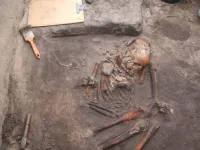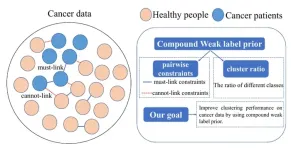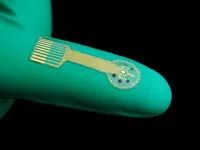(Press-News.org) An important chapter of the history of human occupation on the coast of Brazil is being rewritten by Brazilian researchers affiliated with the University of São Paulo’s Museum of Archeology and Ethnology (MAE-USP) and supported by FAPESP.
In an article published in the journal PLOS ONE, the group, which also includes researchers in Santa Catarina state, South Brazil, and in other countries (the United States, Belgium and France), shows that the sambaqui builders of Galheta IV, an archeological site in Laguna (Santa Catarina), were not replaced by ancestors of the Southern Jê, as previously thought.
As the article explains, sambaquis are middens that constitute “evidence of long-term occupation”. They consist of mounds with layers of shellfish debris, human and animal bones, remains of plants and hearths, stone or bone utensils, and other refuse. They were used for burial and shelter, and to demarcate territory.
“There was far less interaction than has been thought between these midden builders [sambaquieiros] and the proto-Jê populations, as we call them. Their funerary practices and pottery were different. Moreover, the sambaquieiros lived there from birth and were descendants of people who had lived in the same place,” says André Strauss, a professor at MAE-USP and penultimate author of the article.
The theory that one ethnic group replaced the other arose partly because sites like Galheta IV mark the end of sambaqui building. The potsherds found in the most recent layers of mounds on these sites recall the pottery of the ancestors of South Jê Indigenous groups Kaingang and Laklãnõ-Xokleng. This is another reason for the long-held belief, now refuted, that the sambaqui builders who lived on the coast were replaced by people from the Santa Catarina uplands.
“We don’t know why sambaqui building stopped. Possible explanations include contact with other cultures and environmental factors such as changing sea levels and salinity, which may have led to a fall in the supply of shellfish and hence of the raw material for shell mounds,” says Jéssica Mendes Cardoso, first author of the article. The study was conducted while she researching for her doctoral thesis at MAE-USP and the University of Toulouse in France.
Cardoso re-analyzed material collected by another team at MAE-USP and the Heritage Education and Archeology Research Group (GRUPEP) at the University of Southern Santa Catarina (UNISUL) between 2005 and 2007, when the skeletons of four individuals were exhumed. In doing so, she quantified the strontium, carbon and nitrogen isotopes, determining that fish and other seafood accounted for 60% of the diet of the group in question. Analysis of the bones also showed that the individuals were not buried after cremation, a funerary practice used by Southern proto-Jê populations.
She also analyzed faunal remains (parts of animals in the material record), especially of fish, which are common in sambaquis. Unlike other sites, this one also had bones of marine birds such as albatrosses and penguins, and bones of mammals such as a fur seal.
“These animals were not part of their daily diet but were consumed seasonally while they were migrating or might have been kept at the site. They were probably part of their funeral rites since no one lived in this place. The site was a burial ground,” Cardoso says. There were 12 albatrosses in one burial unit, for example.
New dating found the site older than was thought, estimating that it was built and frequented between 1,300 and 500 years ago. The previous estimate was 1,170-900 years ago.
Rosetta Stone
Analysis of the pottery found at the archeological site also suggests that the proto-Jê may have been only a cultural influence adopted by the sambaqui builders. Out of 190 potsherds excavated there, 131 were large enough for examination and analysis.
“The pottery is very different from that found in the Santa Catarina uplands, in terms of shape and decoration, but similar to that found at other sites on the coast in both the north and south of the state, showing that these objects may well have been transported from one coastal location to another. These are the oldest pottery remains found in the state, dating from 1,300 years ago, whereas the pottery found in the uplands is about 1,000 years old,” says Fabiana Merencio, second author of the article. During the study, she was a PhD candidate at MAE-USP with a scholarship from FAPESP. She is currently a postdoctoral fellow at the Federal University of Santa Catarina (UFSC).
“We reveal a new expression of human materiality on the coast, some 1,000 years ago, in the shape of substitution for sambaquis of sites without mollusk shells but with pottery. This site is a Rosetta Stone that helps us understand these connections,” Strauss says.
A new research group will now return to the area to study another site (Jabuticabeira II) in a new project supported by FAPESP and led by Ximena Villagran, a professor at MAE-USP.
About São Paulo Research Foundation (FAPESP)
The São Paulo Research Foundation (FAPESP) is a public institution with the mission of supporting scientific research in all fields of knowledge by awarding scholarships, fellowships and grants to investigators linked with higher education and research institutions in the State of São Paulo, Brazil. FAPESP is aware that the very best research can only be done by working with the best researchers internationally. Therefore, it has established partnerships with funding agencies, higher education, private companies, and research organizations in other countries known for the quality of their research and has been encouraging scientists funded by its grants to further develop their international collaboration. You can learn more about FAPESP at www.fapesp.br/en and visit FAPESP news agency at www.agencia.fapesp.br/en to keep updated with the latest scientific breakthroughs FAPESP helps achieve through its many programs, awards and research centers. You may also subscribe to FAPESP news agency at http://agencia.fapesp.br/subscribe.
END
Study proposes novel hypothesis to explain occupation of Brazil’s southern coast 2,000 years ago
Analysis of an archaeological site near the town of Laguna refutes the theory that the ancestors of the Southern Jê replaced the people who built shell middens and burial mounds (sambaquis) for more than 5,000 years on the coast of Santa Catarina state.
2024-06-18
ELSE PRESS RELEASES FROM THIS DATE:
The declining diet of Japan’s youth
2024-06-18
Researchers from the University of Tokyo performed the first study to quantify highly processed food consumption and to investigate its association with diet quality among Japanese children and adolescents. Highly processed foods (HPFs) accounted for over one-fourth of the total energy intake amongst youths. Consumption was negatively associated with the intake of healthy foods, such as fruits, vegetables and pulses, and positively associated with the consumption of confectioneries.
It's common knowledge that poor-quality diets are considered major risk factors for many health issues and even noncommunicable ...
How targeted nutrients can fight cancer
2024-06-18
An international research team has discovered a new way to effectively treat cancer, by using nutrients to reactivate suppressed metabolic pathways in cancer cells.
The researchers used a common amino acid, tyrosine, packaged as a nanomedicine, to change the metabolism of melanoma, a deadly skin cancer, and prevent cancer growth.
Australia has the highest rate of skin cancer in the world. This new approach could be combined with current therapies to better treat melanoma. The technique also has the potential to treat other types of cancer.
The study, Nutrient-delivery and metabolism reactivation therapy for melanoma, was led by Professor Wenbo ...
Constrained clustering with weak label prior
2024-06-18
Clustering is widely exploited in data mining. It has been proved that embedding weak label prior into clustering is effective to promote its performance. Previous researches mainly focus on only one type of prior. However, in many real scenarios, two kinds of weak label prior information, e.g., pairwise constraints and cluster ratio, are easily obtained or already available. How to incorporate them to improve clustering performance is important but rarely studied.
To deal with this problem, a research team led by Chenping ...
New “smart bandages” hold potential for revolutionizing the treatment of chronic wounds
2024-06-18
Chronic wounds, which include diabetic ulcers, surgical wounds, pressure injuries, and other problems, are deadlier than many people realize. Patients with chronic wounds have a five-year survival rate around 70%, worse than that of breast cancer, prostate cancer and other serious diseases. Treating wounds is also expensive, costing an estimated $28 billion each year in the U.S. alone.
A team of researchers from the Keck School of Medicine of USC and the California Institute of Technology (Caltech) is developing a series of cutting-edge technologies to revolutionize wound care, including smart bandages that would automatically sense and ...
Rapid test of cerebrospinal fluid decreases time to diagnosis for brain tumors
2024-06-18
A test that looks for genetic hallmarks of brain cancers in samples of cerebrospinal fluid can decrease the time to diagnosis and eliminate the need for invasive brain biopsies for some patients. Mass General Brigham experts in neurosurgery, cancer and pathology worked together to develop a rapid, genotyping test that can detect key mutations associated with brain cancers from samples taken during a lumbar puncture. The team evaluated the technique known as TetRS (Targeted Rapid Sequencing) among 70 patients admitted to Massachusetts General Hospital with new central nervous system ...
Cyberbullying and sexual harassment rampant in esports
2024-06-18
It’s one of the fastest growing industries globally, raking in millions for the best players and attracting a huge fanbase, but a new Australian study has revealed the dark side of professional video gaming: cyberbullying and sexual harassment.
Even though the esports industry is a diverse community, cyberbullying is rampant in this virtual world, and cis-gendered and trans-gendered women players are disproportionately more likely to be sexually harassed than men.
Despite women making up 46% of the world’s three billion video gamer players, according to a new paper published in Entertainment Computing, women who play professionally (16% of esports competitors ...
New study shows mechanisms of Hagfish burrowing into deep sea sediment
2024-06-18
Scientists at the Schmid College of Science and Technology at Chapman University developed a novel way to observe the elusive burrowing behavior of hagfish. Dr. Douglas S Fudge and his team created a specialized tank of transparent gelatin in order to visualize how the hagfish behave and locomote within sediments.
Hagfishes are bottom-dwelling marine animals that are capable of producing startling amounts of defensive slime when they are provoked. Understanding the burrowing activities of hagfishes could lead to increased knowledge of sediment turnover in marine benthic habitats, new insights into the reproductive behavior of hagfishes or ...
Study suggests at-camera gaze can increase scores in simulated interviews
2024-06-18
Eye-contact has a significant impact on interpersonal evaluation, and online job interviews are no exception. In addition to the quality of a resume, the direction of the interviewee’s gaze might help (or hinder) their chances of securing the job.
Researchers published their results in Scientific Reports on May 31.
The study simulated online job interviews. Twelve students who participated in the study as a role of interviewees presented themselves twice, once looking directly at a web camera, and the other looking towards the screen. ...
NYU Tandon researchers selected for National Artificial Intelligence Research Resource Pilot to enhance AI vision models
2024-06-17
An NYU Tandon School of Engineering project led by Chinmay Hegde – Associate Professor in the Department of Computer Science and Engineering and the Department of Electrical and Computer Engineering – is one of the first 35 initiatives selected for the National Artificial Intelligence Research Resource (NAIRR) Pilot by the U.S. National Science Foundation (NSF) and Department of Energy, a result of President Biden's Executive Order on the Safe, Secure and Trustworthy Development and Use of AI.
The NAIRR Pilot aims to connect U.S. researchers and educators with the computational power, data resources, ...
Investigating the origins of the crab nebula with NASA's Webb
2024-06-17
A team of scientists used NASA’s James Webb Space Telescope to parse the composition of the Crab Nebula, a supernova remnant located 6,500 light-years away in the constellation Taurus. With the telescope’s MIRI (Mid-Infrared Instrument) and NIRCam (Near-Infrared Camera), the team gathered data that is helping to clarify the Crab Nebula’s history.
The Crab Nebula is the result of a core-collapse supernova from the death of a massive star. The supernova explosion itself was seen on Earth in 1054 CE and was bright enough to view during the daytime. The much fainter remnant observed today ...
LAST 30 PRESS RELEASES:
Why metabolism matters in Fanconi anemia
Caribbean rainfall driven by shifting long-term patterns in the Atlantic high-pressure system, study finds
Potential treatment to bypass resistance in deadly childhood cancer
RSV vaccines could offer protection against asthma
Group 13 elements: the lucky number for sustainable redox agents?
Africa’s forests have switched from absorbing to emitting carbon, new study finds
Scientists develop plastics that can break down, tackling pollution
What is that dog taking? CBD supplements could make dogs less aggressive over time, study finds
Reducing human effort in rating software
Robots that rethink: A SMU project on self-adaptive embodied AI
Collaborating for improved governance
The 'black box' of nursing talent’s ebb and flow
Leading global tax research from Singapore: The strategic partnership between SMU and the Tax Academy of Singapore
SMU and South Korea to create seminal AI deepfake detection tool
Strengthening international scientific collaboration: Diamond to host SESAME delegation from Jordan
Air pollution may reduce health benefits of exercise
Ancient DNA reveals a North African origin and late dispersal of domestic cats
Inhibiting a master regulator of aging regenerates joint cartilage in mice
Metronome-trained monkeys can tap to the beat of human music
Platform-independent experiment shows tweaking X’s feed can alter political attitudes
Satellite data reveal the seasonal dynamics and vulnerabilities of Earth’s glaciers
Social media research tool can lower political temperature. It could also lead to more user control over algorithms.
Bird flu viruses are resistant to fever, making them a major threat to humans
Study: New protocol for Treg expansion uses targeted immunotherapy to reduce transplant complications
Psychology: Instagram users overestimate social media addiction
Climate change: Major droughts linked to ancient Indus Valley Civilization’s collapse
Hematological and biochemical serum markers in breast cancer: Diagnostic, therapeutic, and prognostic significance
Towards integrated data model for next-generation bridge maintenance
Pusan National University researchers identify potential new second-line option for advanced biliary tract cancer
New study warns of alarming decline in high blood pressure control in England
[Press-News.org] Study proposes novel hypothesis to explain occupation of Brazil’s southern coast 2,000 years agoAnalysis of an archaeological site near the town of Laguna refutes the theory that the ancestors of the Southern Jê replaced the people who built shell middens and burial mounds (sambaquis) for more than 5,000 years on the coast of Santa Catarina state.





